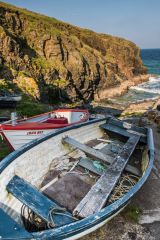
On the eastern edge of Lizard village, on the eponymous Lizard peninsula, lies the ancient parish of Landewednack, the most southerly parish on the British mainland. Landewednack has been largely swallowed up by Lizard village which is now the major settlement in the south of the peninsula.
History
Lizard Point, the most southerly point on the British mainland, lies within Landewednack parish boundaries. At Lizard Point is the restored signal station used by Marconi for his historic wireless experiments.
The parish is centred on St Wynwallow's Church, established in the 6th century by Gwenole, a follower of St Winwallo, or Winwolaus, the abbot of Landevennec in Brittany.
The church boasts some of the oldest bells in Cornwall, and was the site of the very last sermon preached in the Cornish language in 1670 (other accounts give the date as 1678). Large numbers of parishioners died from the plague in 1645.
A century later the area of the graveyard where plague victims were buried was re-opened to bury shipwrecked mariners, and the plague reappeared. To make sure the plague did not re-emerge that area of the graveyard was planted over and fenced off from the rest. It has never been used again.
From Church Cove Road a footpath leads to a lifeboat station at Kilcobben Cove.

Just off Beacon Terrace, on the edge of Lizard village, is a Methodist Chapel, built in the 1860s and listed Grade II for its historic interest.
On Church Road is Landewednack House built as the rectory in the late 17th century. A short distance to the east is Cove Cottage, a thatched and whitewashed cottage dating to the 17th century.
The area around Lizard Point has a fearsome reputation with sailors, and the Point has seen large numbers of shipwrecks over the centuries. Off the coast of the Lizard are jagged rocks known as The Stags. To counter the threat
The first lighthouse was built on the cliffs overlooking Church Cove in 1619 to a design by Sir John Hilligrew. In 1752 that first building was replaced by the present lighthouse, with two towers using coal fires fed by large coal furnaces. The lighthouse was designed by architect Thomas Fonnereau of Bochym for Trinity House, who still operate it today.
Oil lamps with reflectors replaced the coal furnaces in 1812. There were 27 oil lamps in each tower. In 1878 arc lamps and a fog siren were installed. An engine room was added in 1881, with outbuildings erected in the following year. The twin towers remained in operation until 1903 when a single flashing light was installed in the eastern tower.
Landewednack is a delight to visit. The area around Church Cove is blessed with pretty thatched cottages and the secluded cove is a delight, with far fewer visitors than Lizard Point itself.

About Landewednack, Cornwall
Address: Church Cove,
Lizard,
Cornwall,
England, TR12 7PQ
Attraction Type: Village
Location: On Church Cove Road, off Beacon Terrace and the A3083 in Lizard.
Website: Landewednack, Cornwall
Location
map
OS: SW710125
Photo Credit: David Ross and Britain Express
POPULAR POSTS
HERITAGE
 We've 'tagged' this attraction information to help you find related historic attractions and learn more about major time periods mentioned.
We've 'tagged' this attraction information to help you find related historic attractions and learn more about major time periods mentioned.
Find other attractions tagged with:
NEARBY HISTORIC ATTRACTIONS
Heritage Rated from 1- 5 (low to exceptional) on historic interest
Landewednack, St Wynwallow's Church - 0.1 miles (Historic Church) ![]()
Mullion, St Mellanus Church - 4.5 miles (Historic Church) ![]()
Bonython Estate Gardens - 5.4 miles (Garden) ![]()
Gunwalloe, St Winwaloe's Church - 5.8 miles (Historic Church) ![]()
Halliggye Fogou - 7.1 miles (Prehistoric Site) ![]()
Mawgan Cross - 7.6 miles (Prehistoric Site) ![]()
Mawgan-in-Meneage Church - 7.8 miles (Historic Church) ![]()
Helston Museum - 9.8 miles (Museum) ![]()
Nearest Holiday Cottages to Landewednack, Cornwall:
Lizard Peninsula, Cornwall
Sleeps: 5
Stay from: £475 - 1027
More self catering near Landewednack, Cornwall












